The closing session took place on day 3 of the IFFO conference (26 Octobre 2022).
Climate change: The latest evidence
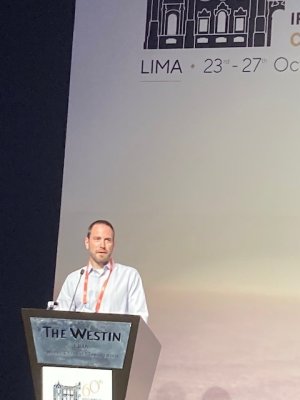 Climate change remains the greatest and growing challenge for fisheries and Dr Christopher M. Free from the University of California-Santa Barbara presented the latest scientific evidence. Free highlighted the critically important role played by forage fish, both as feed and for the ecosystem. The future temperature of the ocean will depend on the reduction of GHGs, with predicted 4-18% decline in stocks depending on temperature rises. However, ocean temperatures have already risen considerably, causing fish populations to shift, impacting population growth rates, with a decline of natural sustainable yield. The severity of loses is directly related to temperature increases, with loss of fish biomass at the equator and increasing biomass at the poles. Impacts are amplified as you move up the food chain, larger species will be most dramatically impacted, with forage fish with lower metabolic rates being less impacted.
Climate change remains the greatest and growing challenge for fisheries and Dr Christopher M. Free from the University of California-Santa Barbara presented the latest scientific evidence. Free highlighted the critically important role played by forage fish, both as feed and for the ecosystem. The future temperature of the ocean will depend on the reduction of GHGs, with predicted 4-18% decline in stocks depending on temperature rises. However, ocean temperatures have already risen considerably, causing fish populations to shift, impacting population growth rates, with a decline of natural sustainable yield. The severity of loses is directly related to temperature increases, with loss of fish biomass at the equator and increasing biomass at the poles. Impacts are amplified as you move up the food chain, larger species will be most dramatically impacted, with forage fish with lower metabolic rates being less impacted.
Fisheries management can also further reduce the negative impacts on our fisheries, reducing overfishing will increases gains in catch, which prove to be a great opportunity to mitigate negative climate impacts. Currently, forage fish are generally well managed, but there is still opportunity to improve the remaining fisheries. There is hope that with good fisheries management and slight emission reduction, there will only be a slight reduction in fisheries biomass by the end of the century. Forage fish are less vulnerable to climate change and management reforms could further offset the losses.
The complicated balance of biodiversity
Fisheries expert Duncan Leadbitter (Fish Matter Pty Ltd) discussed the complicated balance of biodiversity and whether swapping plants for fish in feed is better for the environment. Plant proteins are often set against fish proteins, with heavy criticism of fisheries used to justify changing ingredients in aquafeeds. The many previous and current methods of comparison between the two proteins do not use biodiversity parameters.
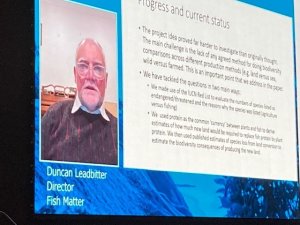 IFFO has driven this project to investigate the relative biodiversity impacts of wild fish versus plants as a source of protein in aquafeed. To gather this knowledge, a workshop was held with fisheries and terrestrial scientists from the UK, US, Sweden and Australia. The final paper has been through multiple iterations and is close to being submitted to a peer reviewed journal for publication. The main challenge was that there was a lack of any agreed methods for doing biodiversity comparisons across different production methods. To tackle this, the authors used the IUCN Red List to evaluate the number of species that were endangered or threatened; and used protein as the common ‘currency’ between plants and fish to derive estimates of how much new land would be required to replace fish protein by plant protein.
IFFO has driven this project to investigate the relative biodiversity impacts of wild fish versus plants as a source of protein in aquafeed. To gather this knowledge, a workshop was held with fisheries and terrestrial scientists from the UK, US, Sweden and Australia. The final paper has been through multiple iterations and is close to being submitted to a peer reviewed journal for publication. The main challenge was that there was a lack of any agreed methods for doing biodiversity comparisons across different production methods. To tackle this, the authors used the IUCN Red List to evaluate the number of species that were endangered or threatened; and used protein as the common ‘currency’ between plants and fish to derive estimates of how much new land would be required to replace fish protein by plant protein.
Key findings note that there are many sources of biodiversity decline, but land conversion for agriculture remains a key contributor and, even for bony fishes, agriculture is a more common threat than fishing. Replacing fish sourced protein with other animal sources can have a very significant impact due to land conversion, and most recent land conversion has involved high diversity tropical forests and savannas. Agriculture’s impacts are largely at the the bottom of the food chain, such as removing native plant-based habitats and replacing with desirable species (but mainly monocultures). Fishing can also have a wide variety of impacts such as overfishing, excessive take of threatened species, habitat impacts (depends on gear type) and ecosystem alteration, but these impacts on biodiversity is substantially less than land use. To conclude, Leadbitter noted that “by and large fishing leaves the base of the food chain largely untouched. Good fisheries management is required to protect fish resources and biodiversity, but ‘fixing’ overfishing by using plants as an alternative seems a step backwards.
Managing the world’s largest fishery
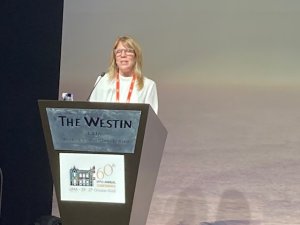 Presenting the latest developments in Peru, Sociedad Nacional de Pesquería’s (SNP) Cayetana Aljovín, opened by noting that the Peruvian fishing sector is a reactivator of the Peruvian economy, supporting 700 thousand jobs and generating US$ 3.5 billion in exports. Currently, the anchoveta biomass is stable, healthy and is around 10 million MT. This is down to a strict quota law, ensuring that only 35% of the biomass can be fished, while the other 65% remains in the sea for reproduction. Juvenile specimens are protected with a strict juvenile catch limit set by IMARPE. Electronic logbooks give real time data so that fishing areas with the highest juvenile incidence can closed within a few hours.
Presenting the latest developments in Peru, Sociedad Nacional de Pesquería’s (SNP) Cayetana Aljovín, opened by noting that the Peruvian fishing sector is a reactivator of the Peruvian economy, supporting 700 thousand jobs and generating US$ 3.5 billion in exports. Currently, the anchoveta biomass is stable, healthy and is around 10 million MT. This is down to a strict quota law, ensuring that only 35% of the biomass can be fished, while the other 65% remains in the sea for reproduction. Juvenile specimens are protected with a strict juvenile catch limit set by IMARPE. Electronic logbooks give real time data so that fishing areas with the highest juvenile incidence can closed within a few hours.
To further demonstrate good fisheries management, Peru began the process of certifying Peruvian anchoveta with the Marine Stewardship Council (MSC) standard. At the end of 2020, the FIP for Peruvian anchoveta was completed, an international audit (SCS Services) was initiated in 2021, the industry is now waiting for the new version of the MSC standard to be released before applying to it. On top of this, 19% of Peruvian plants are already certified against the MarinTrust standard.
Through a series of circular economy measures, the industry has achieved an efficiency of more than 43%, with before 6MT of anchoveta going to 1MT of fishmeal, to now 4.2 MT of anchoveta going to 1MT of fishmeal. Water treatment plants are also in place along with an energy mix of natural gas to reduce emissions. For environmental protection, submarine emitters have been installed ensure a near zero impact on the quality of the receiving marine body. Along with sustainability reporting under the Global Reporting Initiative (GRI) standard, the industry has also set up a fishing recycling scheme (recovering 800MT of nets) and a child nutrition project to combat childhood anemia.
Moving to the Salvamares project, with the aim to protecting the marine ecosystem by monitoring and releasing the main species that interact with the fishing industry. Thanks to the information obtained in real time during fishing activities, there is a low level of interaction between marine mammals and fishing because it would be subject to environmental behavior. Crew members are regularly trained and sensitized on the need for ecosystem sustainability. The implementation of the program in other fisheries is essential to inspire other actors and information to contribute to fisheries management through marine sustainability conferences in which various scientific topics are developed. The results at that by 2022 100 of the Salvamares 228 vessels) have been trained in the identification, registration and release of marine predators. In the north central in 2022 5,160 predators were released, making a grand total of 12,603 since 2017.
Panama and the transition to full certification
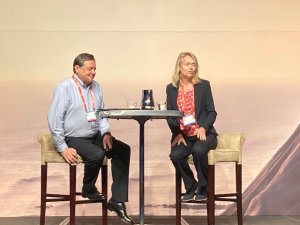 Featuring Libby Woodhatch, Executive Chair of MarinTrust and Brian Murtagh, Managing Director of Animal feeds discussed the journey to certification. Starting over a decade ago, action was taken from a drive from consumers for sustainable practices. At the time, there was just a fishing act from 1977 and only three plant permits and only two were operating, but the Panama fishery had never collapsed but the Panama fishery was given a very poor score from fish source and NGOs, which was mostly to do with the lack of data released by the government.
Featuring Libby Woodhatch, Executive Chair of MarinTrust and Brian Murtagh, Managing Director of Animal feeds discussed the journey to certification. Starting over a decade ago, action was taken from a drive from consumers for sustainable practices. At the time, there was just a fishing act from 1977 and only three plant permits and only two were operating, but the Panama fishery had never collapsed but the Panama fishery was given a very poor score from fish source and NGOs, which was mostly to do with the lack of data released by the government.
In 2015, they joined the MarinTrust Improver Programme, having previously failed on the first audit attempt. The Improver Programme has a timescale of 5 years and is structured to help companies work with government and clients to implement improvements in both the plants and the fleets. Murtagh noted that the programme helped them engage with the government using the FAO sustainable goals. The government then supported and led the FIP and help them install a new fishing law, reducing licenses and compacity, with satellite monitoring and stock assessment so they can now understand their biomass. The FIP has also been enforced with the support of NGOs.
When engaging the fishermen, Murtagh noted that it was a big cultural change, starting with training and aiding endangered species, which had the most positive reaction. From this last year, 1,000 sharks and 24 turtles were rescued and returned alive. Monitoring of birds has also greatly increased their knowledge on species such as pelicans. At the plant, less change was needed as they had already made the transition from GMP to GMP+, making the step up to MarinTrust much easier.
When asked what his recommendations to others would be, Murtagh answered : “just start, many countries and small size fisheries can achieve this, we have seen that many are still not certified and we need to grow to ensure we become a premium ingredient. This is an on-going process which the whole marine ingredients need to join in.”
Global action for marine ingredients
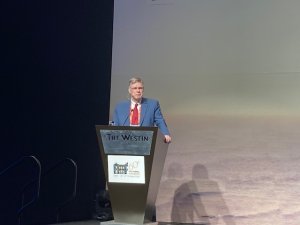 Presenting the latest from the Global Roundtable on Marine Ingredients, Independent Chair Árni Mathiesen gave an update on the four workstreams that are underway. Launched jointly by IFFO and the Sustainable Fisheries Partnership (SFP), the Roundtable is a sector wide, multi-stakeholder initiative, working to drive environmental and social improvements in key fisheries globally. As well as the workstreams, the Roundtable is also engaging with stakeholders and the media. Mathiesen noted that the Roundtable is carrying on discussions on many of the challenges already mentioned at this conference.
Presenting the latest from the Global Roundtable on Marine Ingredients, Independent Chair Árni Mathiesen gave an update on the four workstreams that are underway. Launched jointly by IFFO and the Sustainable Fisheries Partnership (SFP), the Roundtable is a sector wide, multi-stakeholder initiative, working to drive environmental and social improvements in key fisheries globally. As well as the workstreams, the Roundtable is also engaging with stakeholders and the media. Mathiesen noted that the Roundtable is carrying on discussions on many of the challenges already mentioned at this conference.
The first workstream is focusing on West African fisheries to gather knowledge on environmental and socio-economic aspects to understand and address food security and other socioeconomic concerns. A project has been started with Partner Africa, and the group is also supporting the Mauritanian FIP and liaising with the FAO on their recent reports and engaging with media to explain the situation.
The second workstream is focusing on South and Southeast Asian fisheries to supporting responsible production of fishmeal and oil to meet market demand. Work includes aiding FIP development within local fisheries, monitoring the situation in Vietnam and in the Gulf of Thailand through improvement projects led by MarinTrust and through a Global Environment Facility (GEF/FAO) project led by SFP. Then in India, where aquafeed producers are experiencing challenges in sourcing fishmeal and oil from certified responsible fisheries or fisheries in assessment through a Fisheries Improvement Program (FIP). Consultancy work has started to assess the needs for a FIP or several FIPs to be re activated and started in India.
Looking at the present situation, both the recent SFP reduction fisheries report and FAO SOFIA report have shown that fisheries are overall considered to be doing reasonably well from a management point of view and to have improved. But there are concerns on management of stocks, ecosystems, human consumption and food security, and community and equity issues. “From our fleets to our factories we leave an environmental and social footprint with nature, we need to be aware and engage and this is what the roundtable is doing.”
The future of ingredients will be impacted by a host of interactions, including between aquaculture and wild stocks, conventional terrestrial feed sources, additional seaweed, algae, marine bacteria sources and novel feed. “This industry is doing well and we need to be positive, but keep on seizing the moment.”
Be responsible ambassadors for the marine ingredients industry
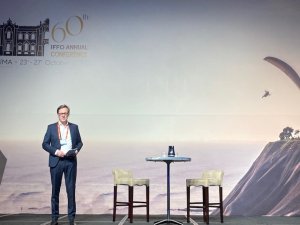 Closing the conference, IFFO’s Director Petter Martin Johannessen noted that this unique gathering of the marine ingredient community has provided insights and connections that we have all been missing over the last two years. “This conference has shown that the marine ingredients industry is demonstrating strong leadership: with a strong sense of commitment, through “courageous collaborations” and “Science Based Targets”, taking a leadership role in pre-competitive collaboration as a powerful means to drive improvements globally, and embracing a 360-degree analysis of its scope of responsibility. The industry has a long-term vision for the ocean, for communities, for business, and for people. We are playing a vital part in the discussions that will shape our future: nutrition through blue foods; climate change mitigation; sustainability trade-offs.
Closing the conference, IFFO’s Director Petter Martin Johannessen noted that this unique gathering of the marine ingredient community has provided insights and connections that we have all been missing over the last two years. “This conference has shown that the marine ingredients industry is demonstrating strong leadership: with a strong sense of commitment, through “courageous collaborations” and “Science Based Targets”, taking a leadership role in pre-competitive collaboration as a powerful means to drive improvements globally, and embracing a 360-degree analysis of its scope of responsibility. The industry has a long-term vision for the ocean, for communities, for business, and for people. We are playing a vital part in the discussions that will shape our future: nutrition through blue foods; climate change mitigation; sustainability trade-offs.
By demonstrating strong leadership, the industry is enhancing its connection to the world, its stakeholders and its customers. Let’s stay focused and be responsible ambassadors for the marine ingredients industry.”








